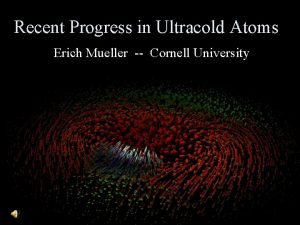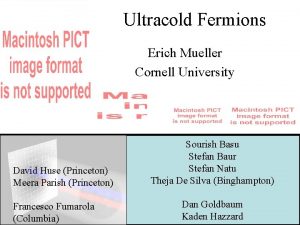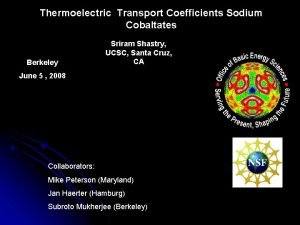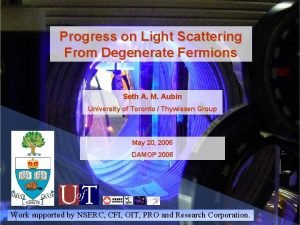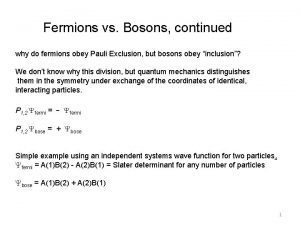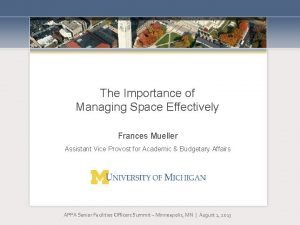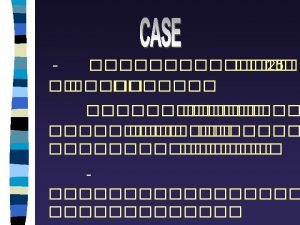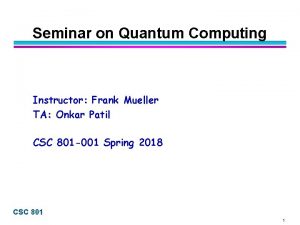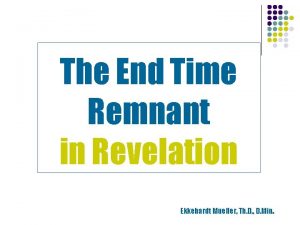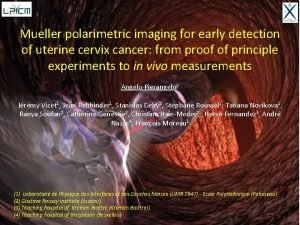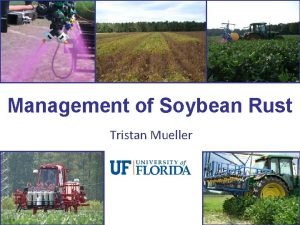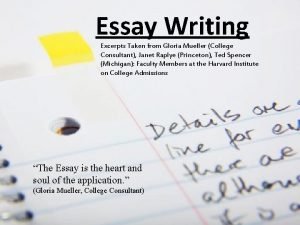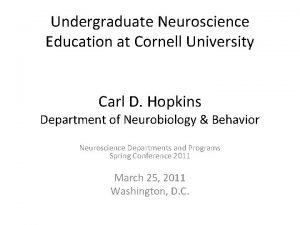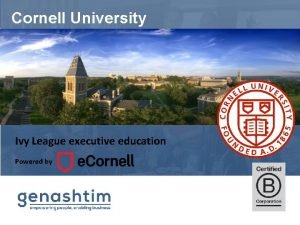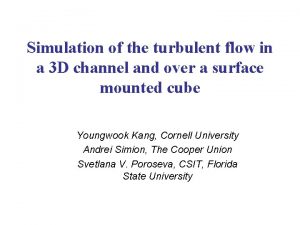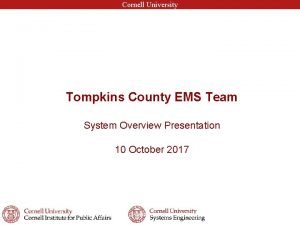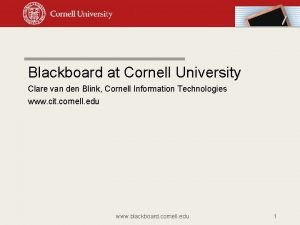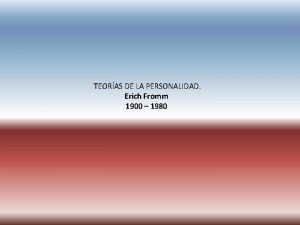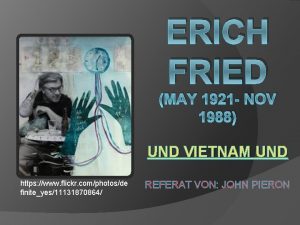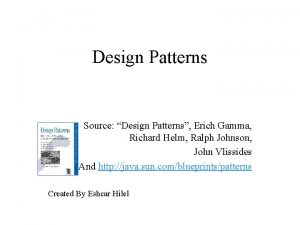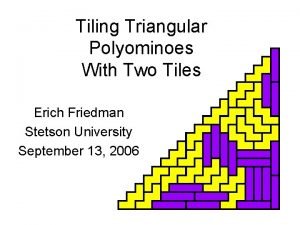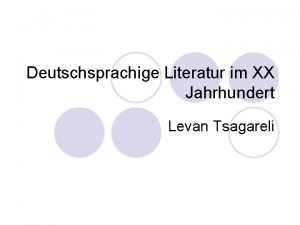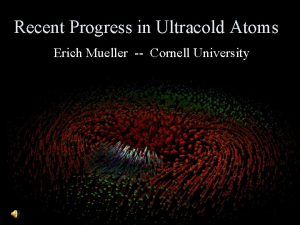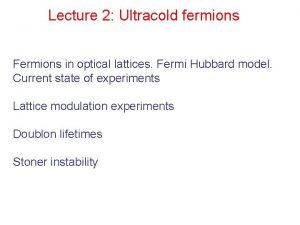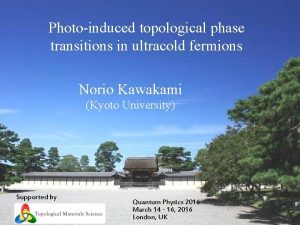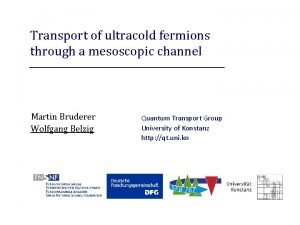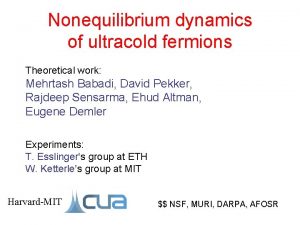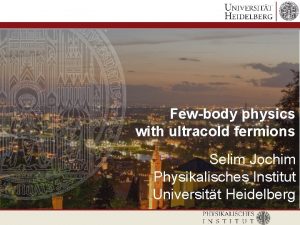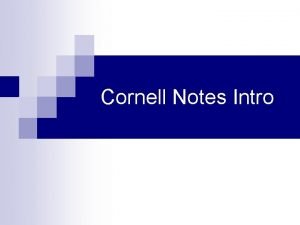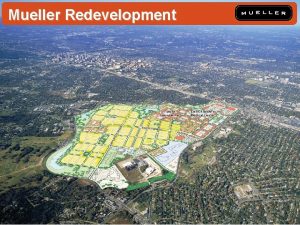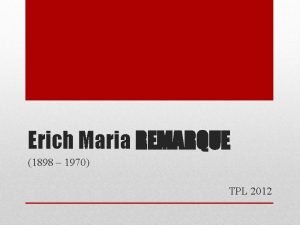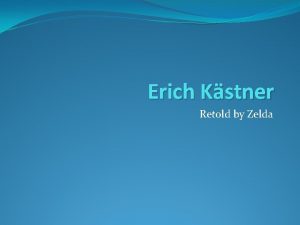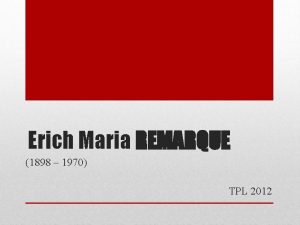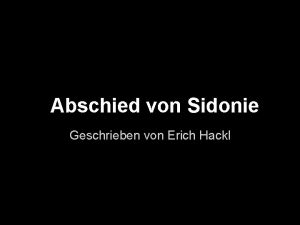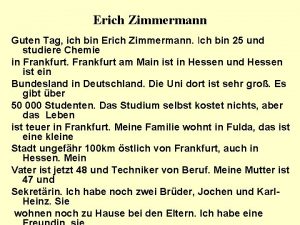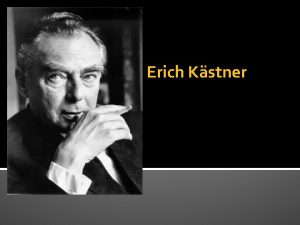Ultracold Fermions Erich Mueller Cornell University David Huse




































- Slides: 36

Ultracold Fermions Erich Mueller Cornell University David Huse (Princeton) Meera Parish (Princeton) Francesco Fumarola (Columbia) Sourish Basu Stefan Baur Stefan Natu Theja De Silva (Binghampton) Dan Goldbaum Kaden Hazzard

Fermi Systems Neutrons in Nuclear Matter Strong overlap in relevant models and phenomena (magnetism, superconductivity…) Electrons in Metals Lithium atoms in optical traps Hard problems: emergent physics (record temp: 500 p. K) Unity of description: why we love physics.

Outline Recent Progress BCS-BEC crossover Revisiting superconductivity Near future Pseudogap physics Modulated superfluidity Supressing superfluidity (FFLO) (Polarization and surface tension) Use atomic systems to explore most exciting ideas in many body physics Many other exciting phenomena: spin models, quantum hall effects, artificial light, Hubbard models… Other directions: metrology, quantum computing…

Quantum Statistics High T: Boltzmann distribution Low T: Degenerate gas Hulet

Superfluidity Bosons: hot cold Atoms delocalized (Heisenberg) 1. Collective transport: no dissipation 2. BEC: state “unchanged” by adding/removing boson Fermions: Interactions drive pairing: Pairs are Bosons: Superfluid

BCS-BEC Crossover Leggett Weak attractive interactions No bound state in free space V r V 0 BCS Pairing is many-body effect (Fermi surface reduces dimensionality) Pairing and superfluidity occur simultaneously r 0 Continuously connected (Experiment: tune interactions with magnetic field) Strong attractive interactions Pairing (crossover) precedes superfluidity (phase transition) V r BEC

Transition temperature Tc/TF BCS-BEC landscape BEC Figure: M. Holland et al. , PRL 87, 120406 (2001) BCS 0 10 -2 10 Alkali BEC Superfluid 4 He BCS-BEC crossover regime High Tc superconductors Superfluid 3 He -4 10 Superconductors (Cooper pairs) -6 10 10 10 5 10 -5 10 Binding energy of Fermionic pairs or gap energy BF Energy D k. T in units of 2/Fermi

Phase diagram 6 Li or 40 K Pairs shrink Normal BEC BCS Superfluid V r B V B 0 r Free space: bound state at threshold (universal thermodynamics) V r Experiments confirm phase diagram Most theory and experiment done here

Universality and Unitarity V r Bound state has infinite size: no energy scale from potential Cross-section as large as possible (determined by conservation laws) Thermodynamic functions -- universal functions of density and temperature Ex: Same for nucleons as for atoms!

How to experimentally detect superfluidity? Vortices Ketterle group: Nature 435 , 1047 -1051 (2005). Q: Nature of normal state Pseudogap Specific heat: Thomas group: Phys. Rev. Lett. 98, 080402 (2007)

What is pseudogap? (in BCS-BEC crossover literature) Gap: Superfluid No low energy fermionic excitations Atoms bound in condensed pairs Colloquial pic: energy cost of breaking pairs gives gap More precise: quantum interference of particle and hole states Pseudogap: Normal Few low energy fermionic excitations Atoms bound in non-condensed pairs: Gap “blurred out” by incoherently adding contributions from pairs with different momenta

What is pseudogap? (in BCS-BEC crossover literature) BCS spectral density (what is energy of excitations with momentum k? ) Idea: two ways to add particle 1. Simply insert particle

What is pseudogap? (in BCS-BEC crossover literature) BCS spectral density (what is energy of excitations with momentum k? ) Idea: two ways to add particle 1. Simply insert particle 2. Insert pair, and a hole (adding pair leaves state unchanged -- Condensate)

What is pseudogap? (in BCS-BEC crossover literature) BCS spectral density (what is energy of excitations with momentum k? ) Idea: two ways to add particle 1. Simply insert particle 2. Insert pair, and a hole 3. States hybridize

What is pseudogap? (in BCS-BEC crossover literature) BCS spectral density (what is energy of excitations with momentum k? ) Idea: two ways to add particle 1. Simply insert particle 2. Insert pair, and a hole 3. States hybridize Add “coherence factors”

Superfluid What is pseudogap? (in BCS-BEC crossover literature) Pseudogap spectral density (what is energy of excitations with momentum k? ) Normal 1. Insert particle

Superfluid What is pseudogap? (in BCS-BEC crossover literature) Pseudogap spectral density (what is energy of excitations with momentum k? ) Normal 1. Simply insert particle 2. Insert hole and pair • Many ways to do this

Superfluid What is pseudogap? (in BCS-BEC crossover literature) Pseudogap spectral density (what is energy of excitations with momentum k? ) Normal 1. Simply insert particle 2. Insert hole and pair • Many ways to do this 3. Hybridize + + +…

Superfluid What is pseudogap? (in BCS-BEC crossover literature) Pseudogap spectral density (what is energy of excitations with momentum k? ) Normal Structures persist at weaker coupling: (less broadening)

How to experimentally see pseudogap? Grimm group, Science 305, 1128 (2004) RF spectroscopy Empty Pairs B [Gauss] Decreasing T 7 Li Continuum of final state k Challenges: -k final state interactions, trap inhomogeneities (current controversies) Mueller, Ar. Xiv: 0711. 0182; Basu and Mueller, ar. Xiv: 0712. 1007 dn [k. Hz] (example with tightly bound pairs)

Is crossover pseudogap a novel quantum Liquid? T>Tc~0. 5 TF -- Not very degenerate (metal at 105 K) No sharp quasiparticles: thermal effect? Need to suppress TC Solution: Polarize gas (spin relaxation negligible) Connected to questions of [1964], interplay. Larkin of superconductivity and magnetism and Ovchinnikov [1965] History: Fulde-Ferrel Looking for FFLO state is x among goals of future experiments Buzdin, Nature Materials (2004)

Observation: Phase separation MW. Zwierlein, A. Schirotzek, C. H. Schunck, and W, Ketterle: Science 311, 492 -496 (2006) Superfluid core with polarized halo

Phase diagram (at unitarity) Comparison: liquid-gas (cf: 3 He-4 He) Ketterle group: Nature (Feb 7, 2008)

Surface Tension • Phase Coexistence -> Surface Tension 60 mm 1 mm Aspect Ratio of Cloud: 50: 1 Aspect Ratio of Superfluid: 5: 1 Data: Hulet (unpublished) Amusing aside: Initial experiments: axial density -- discrepancy between experiments

More Data: Hulet group -- Nuclear Physics A (2007)

Origin of Surface Tension E SF D D 0 Order parameter passes over barrier in going between spatially separated phases Normal

Numerical Calculation kfa=-20 At unitarity, surface tension parameterized by single universal number Normal - extract approx value from Bd. G Stefan Baur

Global consequences: soap bubble physics z Why “square” ends? Interplay of trap and surface tension Data: Hulet group -- Nuclear Physics A (2007) Large anisotropy: at each z imagine infinite cylindrical bubble E Critical droplet Bubble radius Natu and Mueller, ar. Xiv: 0802. 2083

Soap bubble physics z Why “square” ends? Data: Hulet group -- Nuclear Physics A (2007) E Critical droplet Minimum moves up as z increases: “ 1 st order transition” Bubble radius Natu and Mueller, ar. Xiv: 0802. 2083

How does pseudogap evolve with polarization? Fumarola and Mueller, ar. Xiv: 0706. 1205 T N S Forbidden • Sharp fermions at Fermi energy • Pseudogap smearing pushed to Polarization finite energy • Pairs exist as excitations

How does pseudogap evolve with polarization? Fumarola and Mueller, ar. Xiv: 0706. 1205 T N S Forbidden • Sharp fermions at Fermi energy • Pseudogap smearing pushed to Polarization finite energy • Pairs exist as excitations

Summary/Outlook • Recent work: Strong coupling superfluidity – BCS-BEC Crossover – Pseudogap – Polarization: phase separation • More General – Cold atoms: controlled environment for studying collective effects in degenerate quantum systems • Future – FFLO x

Analogies • “Pasta” phases of nuclear matter • “Stripe phases” of high temperature superconductors

Stability of FFLO? x Short range interactions: generally favor bulk phase sep T=0 Mean-field calculation Normal Superfluid FFLO red region

Future experiments -- Quasi-1 D enhance CDW/SDW instability Arrays of coupled tubes 1 D--fluctuating FFLO phase very stable FFLO S N Boost Tc by coupling tubes (Bethe Ansatz)

Phase diagram for coupled tubes Meera M. Parish, Stefan K. Baur, Erich J. Mueller, David A. Huse Phys. Rev. Lett. 99, 250403 (2007)
 Erich mueller cornell
Erich mueller cornell David huse
David huse Heavy fermions
Heavy fermions Pauli blocking of light scattering in degenerate fermions
Pauli blocking of light scattering in degenerate fermions Fermions obeys
Fermions obeys Vendia huse
Vendia huse Koncept house atlanta
Koncept house atlanta Martin seligman kerry mueller
Martin seligman kerry mueller Frances mueller
Frances mueller Mueller hillis maneuver
Mueller hillis maneuver Frank mueller ncsu
Frank mueller ncsu Mueller park jr high
Mueller park jr high Medium
Medium Ekkehardt mueller
Ekkehardt mueller Mueller
Mueller Martin elias peter seligman
Martin elias peter seligman Moritz mueller swinburne
Moritz mueller swinburne Lisel mueller immortality
Lisel mueller immortality Pat mueller
Pat mueller Omegascans
Omegascans Soybean rust life cycle
Soybean rust life cycle Chuck mueller
Chuck mueller Gloria mueller
Gloria mueller Cornell university neuroscience
Cornell university neuroscience Cornell university executive education
Cornell university executive education Cornell university fluent laminar pipe flow
Cornell university fluent laminar pipe flow Cornell ems
Cornell ems Blackboard cornell edu
Blackboard cornell edu Personalidad erich fromm
Personalidad erich fromm Erich paul remark
Erich paul remark Henning kurz
Henning kurz Erich fried biographie
Erich fried biographie Design patterns erich gamma
Design patterns erich gamma Erich friedman
Erich friedman Pengertian cinta kasih menurut para ahli
Pengertian cinta kasih menurut para ahli Remarque současníci
Remarque současníci Erich fried gebranntes kind
Erich fried gebranntes kind
